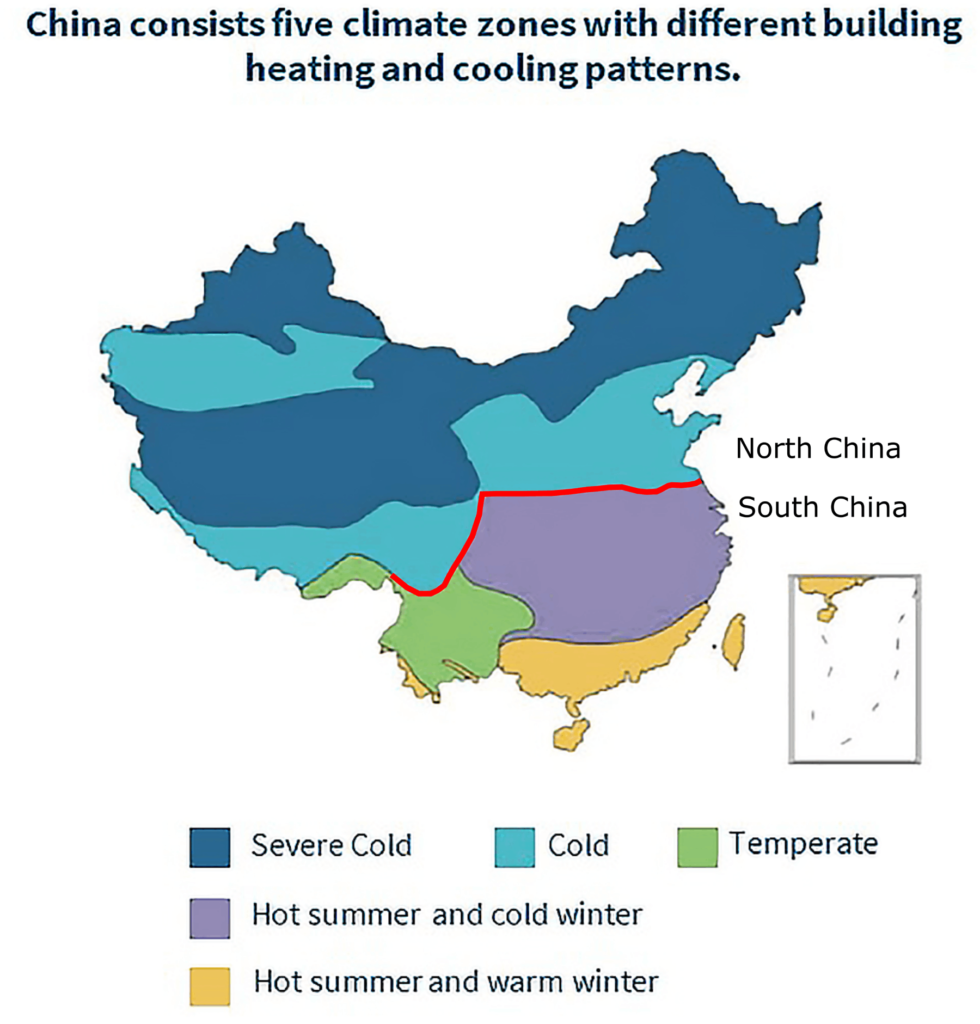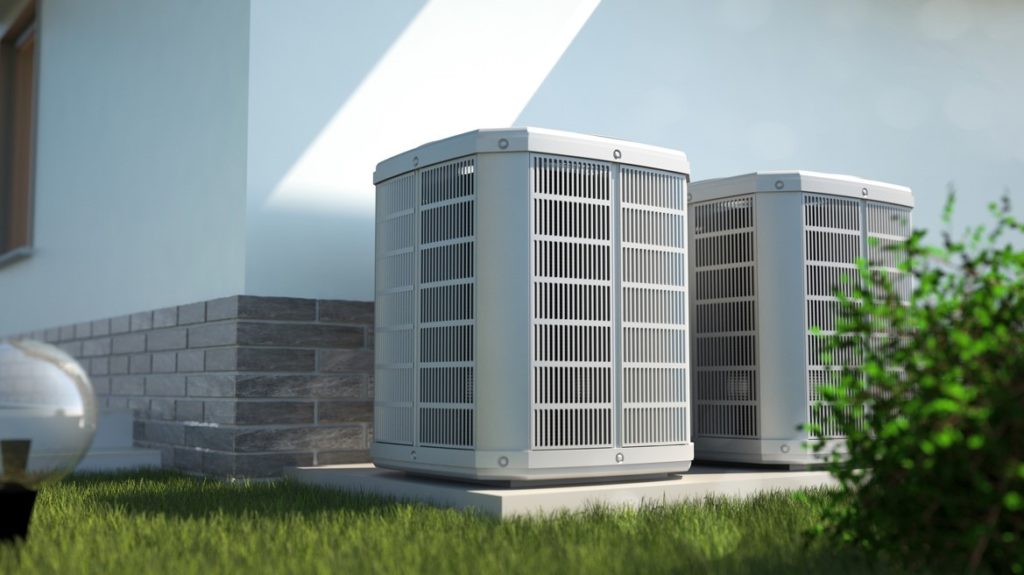
Zero-Carbon Heating in China
Heating accounts for approximately 20 percent of total building energy use in China, making it the most significant carbon emitter in the buildings sector. Reducing heating energy consumption is crucial to reach China’s climate goal of 2060 carbon neutrality.
Different Climate Zones Mean Different Heating Needs
China covers a vast geographic area and is officially divided into five major climate zones with different thermal design requirements. Northern China, which consists of the two coldest climate zones, needs space heating in winter. The urban areas mostly rely on district heating systems, whereas rural areas mostly use individual household heating systems. Another climate zone that has a rising demand for heating is the hot summer and cold winter climate zone. Due to historic reasons, there is no public infrastructure nor services to provide district heating systems for buildings in this climate zone, and buildings generally lack effective heating services. Therefore, the northern and southern regions in China face different challenges for heating and need tailored solutions.

A Breakthrough Technology for Northern China
China has and continues to experience rapid urbanization with more than 3,500 new urban development districts (ranging from 10 km2 to 300 km2) being planned or under construction. With the growing urban areas in north China, northern urban heating demand is soaring, and how to provide this heating with reduced carbon emissions has become a critical public service issue.
A breakthrough technology employing an absorption heat pump to utilize industrial waste heat for district heating was first developed in 2008, and has become the most effective solution to meet the growing district heating demand without burning more gas or coal. Based on thermodynamics, the technology ingeniously combines heat exchangers and absorption heat pumps, increasing the temperature difference between supply and return water from the business-as-usual 60°C–70℃ to 90°C–110℃, thus improving the district heating network delivery capacity by 80 percent. With lower return water temperature for the network, the technology could recover waste heat from industrial process and thermal power generation, reducing the cost 40 percent over conventional combined heating and power generation.
After years of planning, testing, and construction, in 2019, the first large-scale demonstration project with absorption heat pumps was activated in Taiyuan, the capital city of Shanxi Province in Northwest China. Thermal power generation waste heat in Gujiao city is recovered by the technology and delivered to about 25 million households in Taiyuan, 70 km away, through a long-distance district heating network. Compared with the conventional approach, this innovative solution utilizes free heat instead of burning coal or gas, saving 50 percent of the cost and 3 million tons of CO2 emissions compared with coal boilers.
The success of the Shanxi demonstration project has proven that the breakthrough technology could be an effective solution for northern urban heating in China. The waste heat of industrial plants and thermal power plants within a radius of 200 km around the city can be recovered by this innovative technology and delivered to buildings for heating in the winter through a long-distance heating pipeline. If 50 percent of northern urban heating areas adopt this technology, it could reduce carbon emissions by 200 million tons per year.
Challenges for Growing Heat Demand in Southern China
Currently, people who live south of the Yangtze River in the hot summer and cold winter climate zone do not have sufficient heating service even when the outdoor temperature falls below 5°C in January and February. And the heating demand of residents in this area is predicted to increase three to four times in the near future. This growing demand for heating the homes of hundreds of millions of people in hot summer and cold winter regions will become one of the biggest risks for China to achieve its climate goals.
With the absence of market guidance and mandatory design codes, consumers lack awareness of the options for clean heating. Currently, household gas boilers are the first choice for many consumers due to the technology’s maturity. However, people are generally not aware that gas boilers have a potential negative impact on both climate and health. Moreover, China has a shortage of natural gas supply, especially in the east. If all the increasing heating demand in the hot summer and cold winter climate zone were met by gas boilers, China will suffer severe gas shortages and price spikes. Furthermore, with 15 to 20 years of service lifespan, a heating system has a strong lock-in effect. Therefore, we must take actions today to promote gas-free solutions for heating in this zone.
Huge Market Opportunities for Heat Pumps in Southern China
Air/water/ground source electrical heat pumps are one of the most important gas-free heating solutions. Electrical heat pumps are significantly more energy efficient than simple electrical resistance heaters. Air source heat pumps are powered by electricity, and extract heat from the external ambient air (air conditioners are essentially heat pumps working in reverse). Within temperature ranges from −3°C to 10°C, heat pumps are extremely efficient. And the efficiency increases as the external temperature rises. Water source heat pumps and ground source heat pumps can be even more efficient as a result of the higher thermal storage capacity of water or soil.
South China’s increasing heating demand presents a great market opportunity for heat pumps. Different types of heat pumps are suitable for different application scenarios—household, building, and district. The market size for air/water/ground source electrical heat pumps could reach 500 billion. With rising consumer awareness and policy incentives, the market will gradually grow and provide investment opportunities and support to develop more mature heat pump solutions.
RMI is working with key stakeholders to scale whole-system solutions supported by the adoption of heat pumps. The work includes developing advanced and innovative pathways, exploring innovative business models, and providing policy recommendations and supporting pilots to meet the growing heating demand through clean, economical, and highly efficient solutions.

Outlook for Zero-Carbon Heating in China
The huge difference between northern and southern China results in different heating options and different pathways toward zero-carbon heating. Absorption heat pumps and waste heat utilization for district heating could be scaled up in north China and similar climate zones in other countries. Air/water/ground source electrical heat pumps are the gas-free solutions for south China and need to be further developed to meet the huge market opportunities.
Taking the zero-carbon heating pathway combined with a higher penetration of renewables on the grid could contribute 20 percent of the emissions reductions necessary to reach the carbon-neutrality goal. Zero-carbon heating with heat pumps as the core will reshape the heating industry in China.
